Does Butterfly Pea Tea Taste Like This?
Butterfly pea tea presents a delicate tapestry of flavors. Its earthy undertones mingle with subtle floral notes, offering a mildly sweet and grassy nuance that becomes a soothing refreshment.
The tea's smooth texture enhances its light, comforting profile, with taste variations influenced by brewing time and water temperature. The harmonious blend of natural richness and mild sweetness creates a sophisticated yet gentle experience.
Adding a touch of lemon can further transform its color and flavor, making it a versatile beverage. To uncover the intricate details and culinary applications of this unique tea, continue exploring its profile.
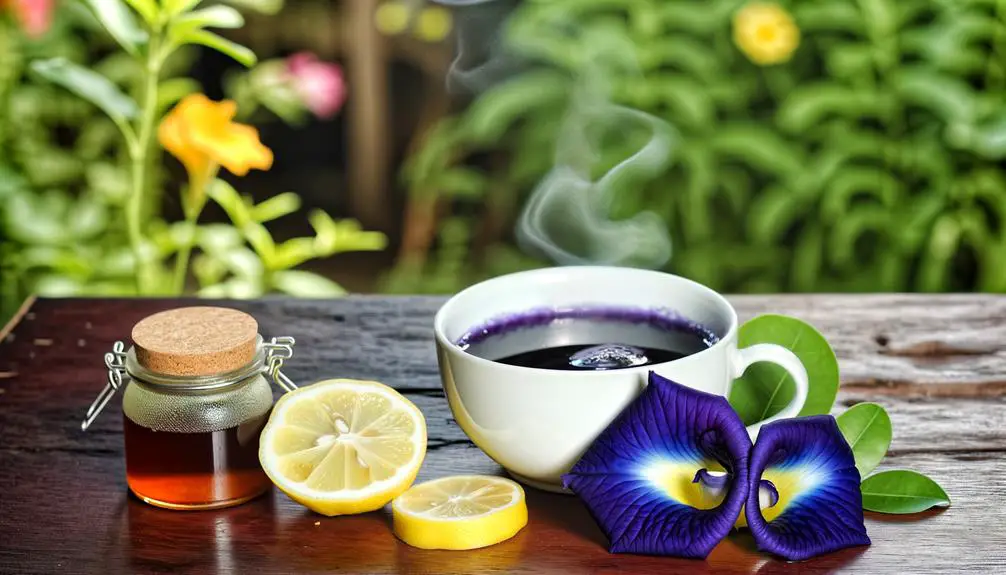
Key Takeaways
- Butterfly pea tea features a delicate balance of earthy undertones and subtle floral notes.
- It has mildly sweet and grassy nuances, providing soothing refreshment.
- The tea's natural sweetness contrasts with mild bitterness, creating a sophisticated taste.
- Smooth and silky texture contributes to a luxurious and light mouthfeel.
Flavor Profile Overview
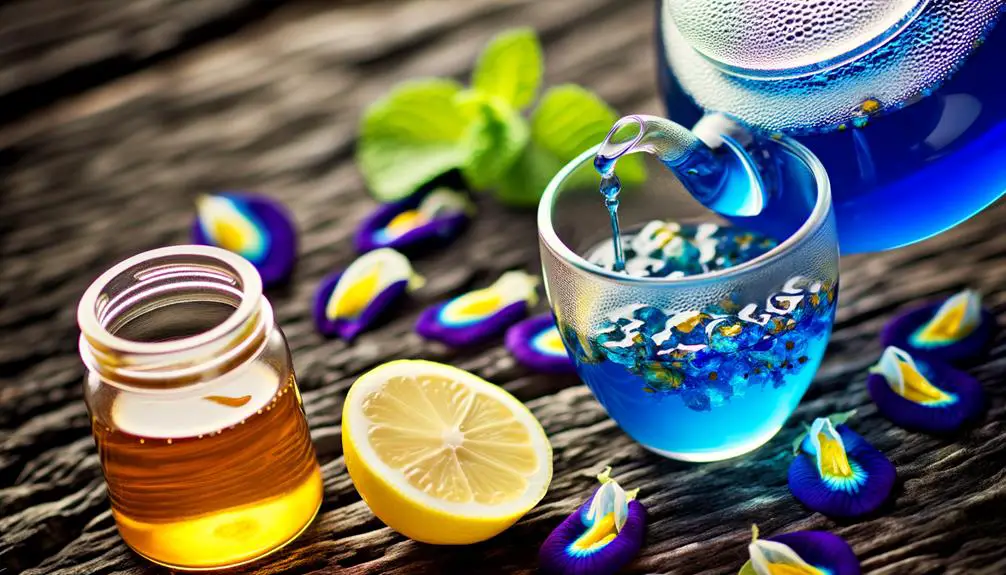
The flavor profile of butterfly pea tea is a delicate balance of earthy undertones and subtle floral notes, offering a unique and invigorating experience for the palate.
This herbal infusion is renowned for its mildly sweet and grassy nuances, which are both soothing and refreshing. A gentle whisper of florality enhances the overall taste, making it neither overpowering nor bland.
The tea's smooth texture complements its light flavor, creating an inviting and comforting beverage.
Significantly, its taste can be influenced by various factors such as brewing time and water temperature, allowing for a customizable experience.
Butterfly pea tea's harmonious blend of flavors provides a sophisticated yet approachable choice for tea enthusiasts seeking something distinctively enjoyable.
Earthy Undertones
Complementing its subtle floral notes, butterfly pea tea's earthy undertones provide a grounded depth that enriches its overall flavor profile.
These earthy nuances imbue the tea with a sense of natural richness and complexity, reminiscent of the forest floor. Such characteristics make the beverage both unique and memorable.
To fully appreciate these earthy undertones, consider the following:
- Steeping Time: Allow the tea to steep for 5-7 minutes to release its full range of flavors.
- Water Quality: Use fresh, filtered water to avoid any interference with the tea's natural taste.
- Temperature: Brew at 190-200°F (88-93°C) to best extract its earthy elements.
- Pairing: Enjoy with mild-flavored snacks that won't overpower the tea's subtleties.
This attention to detail will enhance your tasting experience.
Floral Notes
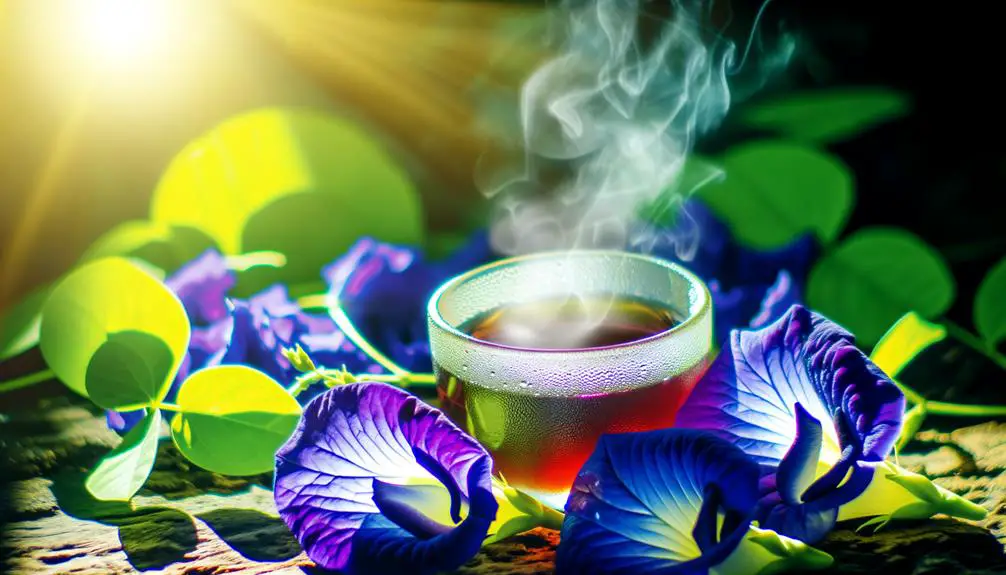
Delicately fragrant, the floral notes of butterfly pea tea evoke a gentle bouquet that enhances its overall sensory appeal. The subtlety of these floral undertones can be likened to the mild aroma of fresh blossoms, providing a soothing and calming effect. This tea's floral essence is not overpowering but rather harmoniously balanced, making it a versatile component in various culinary creations. Its delicate taste profile serves as an excellent base for more complex flavors, whether enjoyed hot or cold.
| Floral Aspect | Description |
|---|---|
| Aroma | Mild, reminiscent of fresh blossoms |
| Primary Floral Note | Subtle and soothing |
| Intensity | Gentle and balanced |
| Versatility | Suitable for diverse culinary uses |
| Complementary Flavors | Pairs well with citrus and herbs |
This nuanced floral character elevates the tea's overall profile, making it a cherished choice for both connoisseurs and casual drinkers.
Sweetness and Bitterness
Balancing a delicate interplay of flavors, butterfly pea tea offers a nuanced sweetness that subtly contrasts with its mild bitterness. This unique combination creates a sophisticated taste experience that intrigues the palate.
The tea's natural sweetness is gentle and unintrusive, manifesting as a soft undertone rather than an overt flavor. In juxtaposition, its bitterness is equally mild, providing a revitalizing counterbalance that enhances the overall profile.
To fully appreciate these characteristics, consider the following:
- Brewing Time: Steeping the tea for shorter periods accentuates its sweetness, while longer steeping may enhance its bitterness.
- Temperature: Using slightly cooler water can bring out sweeter notes.
- Additives: A touch of honey can complement the natural sweetness without overpowering it.
- Serving Method: Enjoy it both hot and cold to explore different nuances.
Texture and Mouthfeel
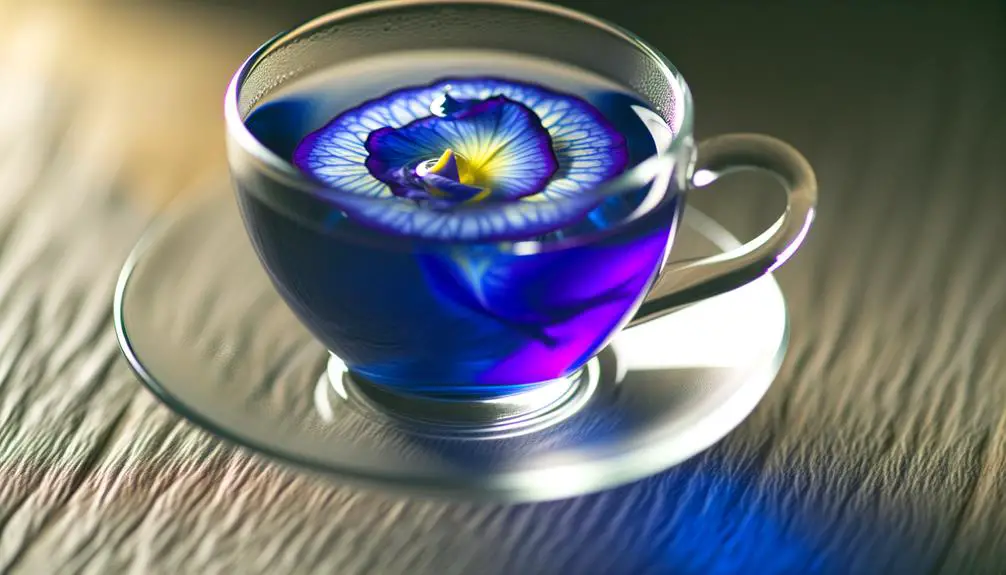
Butterfly pea tea offers an inviting texture that is both smooth and silky, gliding effortlessly across the palate.
The mouthfeel is light and invigorating, making it a delightful choice for any time of day.
This unique combination enhances the overall sensory experience, elevating the simple act of drinking tea into a moment of refined indulgence.
Smooth and Silky
The texture of butterfly pea tea is often described as smooth and silky, creating a luxurious sensation on the palate. This unique mouthfeel is a result of the tea's delicate infusion process, which extracts the subtle flavors without imparting any harshness.
To fully appreciate this texture, consider the following:
- Brewing Time: Steep the tea for just the right duration—too long, and it may lose its silky quality.
- Water Quality: Use filtered or spring water to enhance the tea's smoothness.
- Serving Temperature: Enjoy the tea slightly warm to maximize its silkiness.
- Pairings: Complement with light, non-intrusive snacks to maintain the tea's luxurious mouthfeel.
These elements collectively enrich the tactile experience of butterfly pea tea.
Light and Refreshing
In addition to its smooth and silky texture, butterfly pea tea offers a light and rejuvenating mouthfeel that invigorates the senses. This unique tea captures the nature of a gentle breeze on a warm day, providing a revitalizing experience that is both calming and uplifting.
The tea's delicate composition allows it to glide effortlessly across the palate, leaving a subtle, clean finish. Its lightness makes it an ideal choice for those seeking a beverage that is neither heavy nor overwhelming.
The moderate astringency balances perfectly with a natural sweetness, creating a harmonious blend that is pleasing to both novice and experienced tea drinkers. At its core, butterfly pea tea is a revitalizing escape in every sip. Its vibrant blue hue and delicate earthy notes make it a visually stunning and flavorful choice for any tea enthusiast. As the butterfly pea powder trend continues to grow, more people are discovering its versatility in both beverages and culinary creations. Whether enjoyed hot or cold, this enchanting tea offers a soothing experience that delights the senses.
Pairing With Lemon
Often celebrated for its vibrant color transformation, pairing butterfly pea tea with lemon not only enhances its aesthetic appeal but also introduces a delightful tanginess that complements its subtle earthy flavor.
The addition of lemon instigates a magical shift from blue to purple, enchanting both the eyes and the palate. This combination not only elevates the sensory experience but also adds a revitalizing zest.
To fully enjoy this delightful pairing:
- Squeeze fresh lemon juice into the tea to witness the mesmerizing color change.
- Adjust the lemon quantity to balance the tanginess according to personal preference.
- Serve chilled or hot to suit different occasions and climates.
- Garnish with lemon slices or mint for an added visual and flavor boost.
Versatility in Recipes
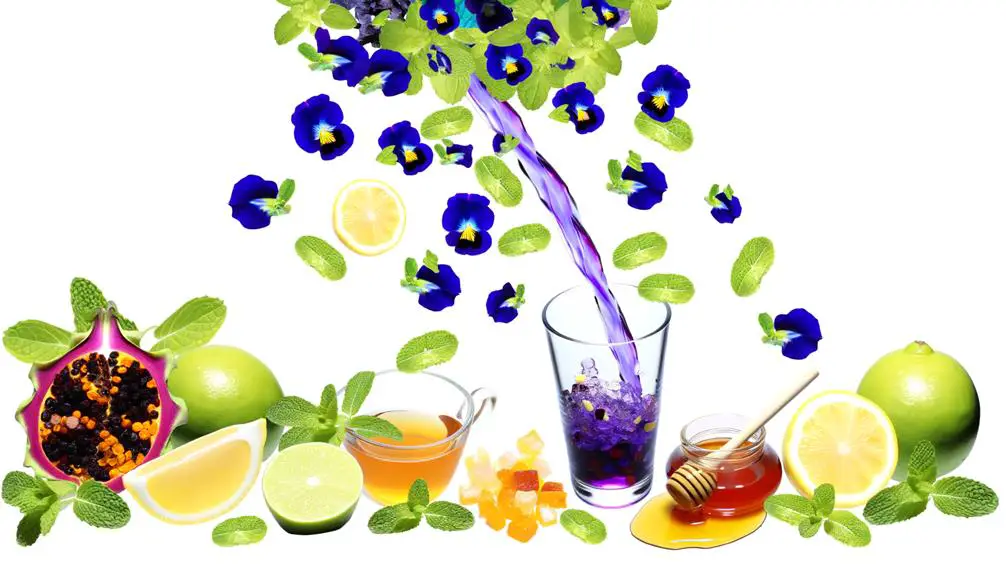
With its unique hue and mild flavor, butterfly pea tea offers a versatile foundation for a myriad of innovative culinary creations. Its natural blue tint can transform dishes into visually stunning experiences, while its earthy notes seamlessly blend with both sweet and savory ingredients.
Consider the following applications:
| Culinary Use | Description |
|---|---|
| Blue Rice | Infuse cooked rice with butterfly pea tea for a visually striking side dish. |
| Colorful Cocktails | Use as a base or mixer for vibrant, Instagram-worthy beverages. |
| Ice Cream | Add to ice cream mixtures for a subtle flavor and eye-catching color. |
| Desserts | Incorporate into cakes, puddings, or jellies for an exotic touch. |
These applications highlight the tea's adaptability, making it a favorite among chefs and home cooks alike.
Conclusion
Butterfly pea tea, with its unique blend of earthy undertones, floral notes, subtle sweetness, and occasional bitterness, offers a complex and intriguing flavor profile.
The texture is smooth, enhancing its versatility in both culinary and beverage applications.
Notably, a study found that adding lemon not only alters the taste but also increases antioxidant levels by up to 50%. This characteristic underscores its potential health benefits and broadens its appeal in diverse gastronomic contexts.






